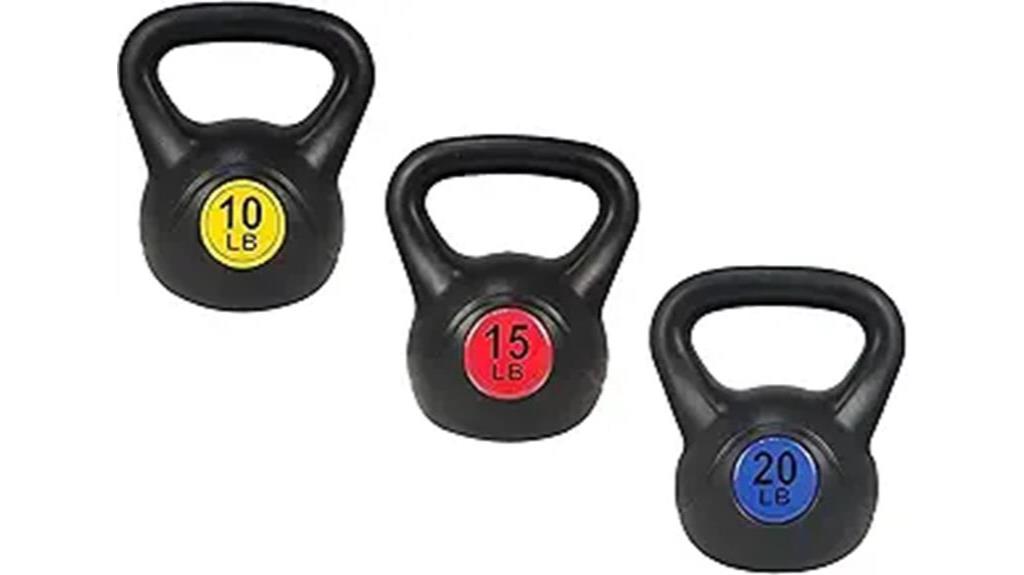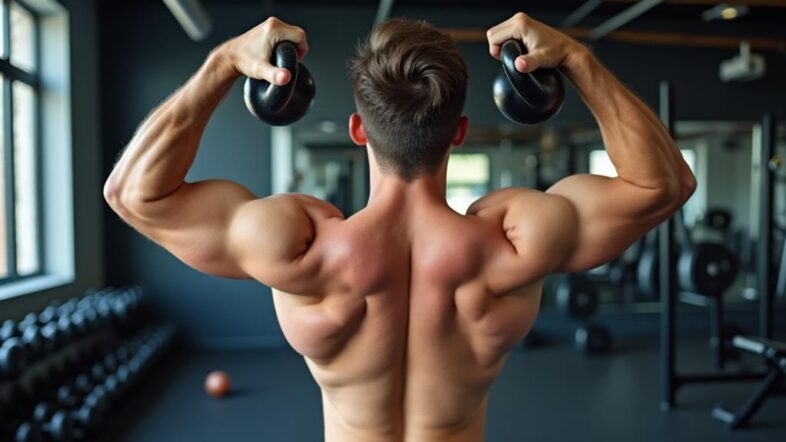Kettlebell Chest Workout
You’re about to discover a Kettlebell Chest Workout that shatters plateaus and transforms your chest muscles, and it starts with choosing the right weight range and grip size that fits your hands comfortably.
A weight range that allows for progressive overload, such as 5-20 lbs, is ideal, enabling you to increase the intensity of your workout as you get stronger.
Combine this with a comfortable grip size, a vinyl-coated handle, and a mix of exercises that target all aspects of your chest muscles.
And you’ll be on your way to a well-rounded routine that targets your pectoralis major, anterior deltoids, and serratus anterior muscles
– and that’s just the beginning of your transformation.
Key Takeaways
- For an effective kettlebell chest workout, choose a weight range that allows for progressive overload, such as 5-20 lbs, to increase intensity as you get stronger.
- Select a kettlebell with a comfortable grip size that fits your hand, as a grip that’s too small or large can compromise form and put unnecessary strain on hands and wrists.
- Incorporate a mix of exercises that target different grip positions, such as neutral, pronated, and supinated, to ensure overall chest development.
- Vary exercise tempo by incorporating slow and controlled movements to build strength, and rapid and explosive movements to improve power and endurance.
- Aim to perform 3-4 sets of 8-12 reps for each exercise to promote muscle growth and endurance in chest muscles.
Wide Grip Kettlebell Exercise Fitness Weight Set

If you’re looking for a kettlebell set that provides a comfortable grip for your chest workouts, the Wide Grip Kettlebell Exercise Fitness Weight Set is an excellent choice.
This set includes four weights: 5, 10, 15, and 20 pounds, each with an ergonomic handle featuring a wide and comfortable grip.
The durable vinyl coating prevents scuffing on your floors, and the cement filling guarantees they won’t leak or rust.
You’ll appreciate the smooth, even coating that won’t cause discomfort during your exercises.
Plus, the gradually increasing grip circumference from 10 to 20 pounds makes it suitable for both one- and two-handed use.
Best For: Fitness enthusiasts, particularly women with smaller hands, who want a comfortable and durable kettlebell set for home workouts and challenging exercises.
Pros:
- Comfortable and ergonomic handle design with wide and smooth grips, suitable for one- or two-handed use
- Durable vinyl coating prevents scuffing on floors and ensures the kettlebells won’t leak or rust
- Gradually increasing grip circumference and balanced design provide stability and versatility for various exercises
Cons:
- No specific weight increments or variations beyond the standard 5, 10, 15, and 20-pound weights
- Coating may eventually wear off with heavy use, although it’s durable and long-lasting
- No carrying case or storage bag is included with the set
Factors to Consider When Choosing a Kettlebell Chest Workout
When selecting a kettlebell for your chest workout, you’ll want to ponder a few key factors. You’ll need to choose a weight range that’s challenging yet manageable, and think about the grip size – a comfortable fit is vital for proper form.
Also, the handle material, exercise variety, and space and portability of your kettlebell will all impact your workout experience.
Kettlebell Weight Range
Selecting the right kettlebell weight range for your chest workout is essential, as it directly impacts the effectiveness and safety of your exercise routine.
As a beginner, you’ll want to start with lighter weights (5-10 lbs) and progress to heavier weights (15-20 lbs) as you build strength and endurance.
A weight range that allows for progressive overload, such as 5-20 lbs, is ideal for chest workouts, enabling you to increase the intensity of your workout as you get stronger.
Consider the specific exercises you’ll be performing, too. Heavier weights are often required for swings and cleans, while lighter weights are suitable for presses and rows.
It’s pivotal to choose a weight range that allows you to maintain proper form and technique, as using weights that are too heavy can lead to injury and compromise the effectiveness of your workout.
Opt for a weight range that offers incremental increases in weight, such as 5 lbs, 10 lbs, 15 lbs, and 20 lbs, to enable precise progressive overload and prevent plateaus in your chest workout.
Grip Size Importance
Your grip on the kettlebell is a critical factor in your chest workout, as it affects the comfort, control, and overall effectiveness of your exercises.
When you’re holding a kettlebell, you want to feel secure and stable, without any slipping or adjusting mid-exercise.
A grip that’s too small or too large can compromise your form and put unnecessary strain on your hands and wrists.
You’ll want to choose a kettlebell with a grip size that fits comfortably in your hand. If you have smaller hands, look for kettlebells with a narrower grip diameter. Conversely, if you have larger hands, you’ll want a kettlebell with a wider grip.
A good rule of thumb is to choose a kettlebell that allows you to wrap your fingers around the handle with a firm but not overly tight grip. This will enable you to maintain control throughout your exercises and focus on targeting your chest muscles.
Remember, a comfortable grip is essential for a safe and effective kettlebell chest workout.
Handle Material Matters
Now that you’ve found a kettlebell with a comfortable grip size, it’s time to ponder the handle material. The material you choose can greatly impact your kettlebell chest workout.
Vinyl-coated handles are a popular choice as they provide a secure grip and are rust-free, making them ideal for high-intensity exercises.
A smooth handle coating is essential to prevent discomfort and scuffing on floors, ensuring a safe and effective workout.
When selecting a handle material, consider durability as well. High-quality materials will last longer and require less maintenance. Also, a wide grip circumference can accommodate both one and two-handed use, allowing for a variety of exercises and versatility in your kettlebell chest workout.
Ergonomic handles with comfortable grips can reduce fatigue and improve overall performance during your workout. By choosing the right handle material, you can optimize your kettlebell chest workout and achieve your fitness goals.
Exercise Variety Needed
As you begin crafting your kettlebell chest workout, it’s essential to prioritize exercise variety to guarantee a well-rounded routine that targets all aspects of your chest muscles.
A mix of presses, rows, and flyes will secure you hit the pectoralis major, anterior deltoids, and serratus anterior muscles.
Don’t forget to incorporate exercises that challenge different grip positions – neutral, pronated, and supinated – to secure overall chest development.
Varying exercise tempo is also pivotal. Incorporate slow and controlled movements to build strength, as well as rapid and explosive movements to improve power and endurance.
Exercises that work multiple planes of motion, such as rotational movements and diagonal patterns, will help improve functional strength and athleticism.
Aim to perform 3-4 sets of 8-12 reps for each exercise to promote muscle growth and endurance in your chest muscles.
By incorporating this variety, you’ll be on your way to a well-rounded kettlebell chest workout that yields impressive results.
Space and Portability
When you’re gearing up for a kettlebell chest workout, the last thing you want is to be held back by a lack of space or a cumbersome weight. That’s why considering the space and portability of your kettlebell is vital.
If you’re planning to work out in a small space, look for kettlebells with a compact design and smooth coating to prevent scuffing on floors or walls. Lighter weights like 5-10 lbs are also more suitable for travel or small spaces, making them a great option.
When choosing a kettlebell set, consider the storage space available at home or in your gym bag. Larger weights like 20 lbs may require more room, so plan accordingly. Ergonomic handles and balanced design can also make a big difference in tight spaces, reducing the risk of accidents or injuries.
If you plan to work out outdoors or in different locations, opt for kettlebells with durable materials and rust-resistant coating to withstand varying environmental conditions.
By taking space and portability into account, you can guarantee a smooth and effective kettlebell chest workout anywhere, anytime.
Budget and Value
Every dollar counts when it comes to choosing the right kettlebell for your chest workout. Consider the cost per pound to guarantee you’re getting the best value.
High-quality options typically range from $1 to $3 per pound. Set a budget and prioritize the weight range you need, as a single kettlebell can cost between $20 to $50 or more, depending on the weight and material.
Think about the long-term value of a kettlebell. A durable and well-made option may cost more upfront, but it’ll last longer and provide a better workout experience.
Be wary of extremely cheap options, as they might be made with low-quality materials or have design flaws that can affect your workout performance and safety.
Calculate the overall cost of ownership, including any potential replacement or upgrade costs. This will help you make an informed decision and guarantee you’re getting the best value for your money.
By considering these factors, you’ll find a kettlebell that fits your budget and meets your workout needs.
Frequently Asked Questions
Can I Use Dumbbells Instead of Kettlebells for a Chest Workout?
You’re wondering if you can swap out kettlebells for dumbbells in a chest workout. Yes, you can! Dumbbells will still engage your chest muscles, but you might need to adjust your grip and stance slightly to get the best results.
How Often Should I Do Kettlebell Chest Exercises per Week?
You’re probably thinking you can just wing a kettlebell chest workout whenever, but consistency is key! Aim to do kettlebell chest exercises 2-3 times a week, with at least a day’s rest in between, to see real progress and avoid plateaus.
Are Kettlebell Swings Effective for Building Chest Muscles?
You’re wondering if kettlebell swings are effective for building chest muscles – honestly, they aren’t, as they primarily target your hips, glutes, and hamstrings, not your chest; you’ll need to focus on other exercises for chest development.
Can I Combine Kettlebell Exercises With Traditional Weightlifting?
Break free from fitness monotony! You can definitely combine kettlebell exercises with traditional weightlifting, creating a dynamic fusion that’ll shock your muscles into growth; just be sure to balance your routine and listen to your body’s cues.
Do I Need to Warm up Before Starting a Kettlebell Chest Workout?
You’ll want to warm up before any intense workout, and kettlebells are no exception. You’re about to challenge your muscles, so don’t skip this step – it’ll prevent injuries and get you ready to tackle that chest workout with confidence!
Conclusion
You’ve got this! With the right kettlebell and a well-rounded workout, you’ll be on your way to building a stronger chest.
Remember, “Variety is the spice of life” – so don’t be afraid to mix it up and try new exercises to keep your muscles guessing.
By considering factors like weight range, grip size, and handle material, you’ll be lifting like a pro in no time.
Stay consistent, stay patient, and you’ll be flexing those pecs in no time!



